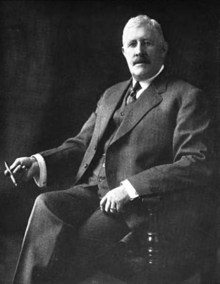William D. Boyce | |
|---|---|
 | |
| Born | William Dickson Boyce June 16, 1858 Plum, Pennsylvania, U.S. |
| Died | June 11, 1929 (aged 70) Chicago, Illinois, U.S. |
| Resting place | Ottawa Avenue Cemetery, Ottawa, Illinois |
| Occupation | Businessman |
| Known for |
|
| Spouses | Mary Jane Beacom
(m. 1884; div. 1908)
(m. 1913)Virginia Dorcas Lee
(m. 1910; div. 1912) |
| Awards | Silver Buffalo Award |
William Dickson Boyce (June 16, 1858 – June 11, 1929) was an American newspaper man, entrepreneur, magazine publisher, and explorer. He was the founder of the Boy Scouts of America (BSA) and the short-lived Lone Scouts of America (LSA).[1] Born in Allegheny County, Pennsylvania, he acquired a love for the outdoors early in his life. After working as a schoolteacher and a coal miner, Boyce attended Wooster Academy in Ohio before moving to the Midwest and Canada. An astute businessman, Boyce successfully established several newspapers, such as The Commercial in Winnipeg, Manitoba, and the Lisbon Clipper in Lisbon, North Dakota. With his first wife, Mary Jane Beacom, he moved to Chicago to pursue his entrepreneurial ambitions. There he established the Mutual Newspaper Publishing Company and the weekly Saturday Blade, which catered to a rural audience and was distributed by thousands of newspaper boys. With his novel employment of newsboys to boost newspaper sales, Boyce's namesake publishing company maintained a circulation of 500,000 copies per week by 1894. Boyce strongly supported worker rights, as demonstrated by his businesses' support of labor unions and his concern for his newsboys' well-being.
By the early years of the 20th century, Boyce had become a multi-millionaire and had taken a step back from his businesses to pursue his interests in civic affairs, devoting more time to traveling and participating in expeditions. In 1909, he embarked on a two-month trip to Europe and a large photographic expedition to Africa with photographer George R. Lawrence and cartoonist John T. McCutcheon. Over the next two decades, Boyce led expeditions to South America, Europe, and North Africa, where he visited the newly discovered tomb of King Tutankhamun.
Boyce learned about Scouting while passing through London during his first expedition to Africa in 1909. According to somewhat fictionalized legend, Boyce had become lost in the dense London fog, but was guided back to his destination by a young boy, who told him that he was merely doing his duty as a Boy Scout. Boyce then read printed material on Scouting, and on his return to the United States, he formed the B.S.A.
From its start, Boyce focused the Scouting program on teaching self-reliance, citizenship, resourcefulness, patriotism, obedience, cheerfulness, courage, and courtesy in order "to make men".[2] After clashing over the Scouting program with the first Chief Scout Executive James E. West, he left the B.S.A. and founded the L.S.A. in January 1915, which catered to rural boys who had limited opportunities to form a troop or a patrol.
In June 1924, five years before Boyce's death, a merger was completed between the B.S.A. and the struggling L.S.A. Boyce received many awards and memorials for his efforts in the U.S. Scouting movement, including the famed "Silver Buffalo Award".
- ^ "William D. Boyce". Points of Light. The Extra Mile. 2007. Archived from the original on September 20, 2008. Retrieved October 11, 2008.
- ^ Cite error: The named reference
pett34was invoked but never defined (see the help page).